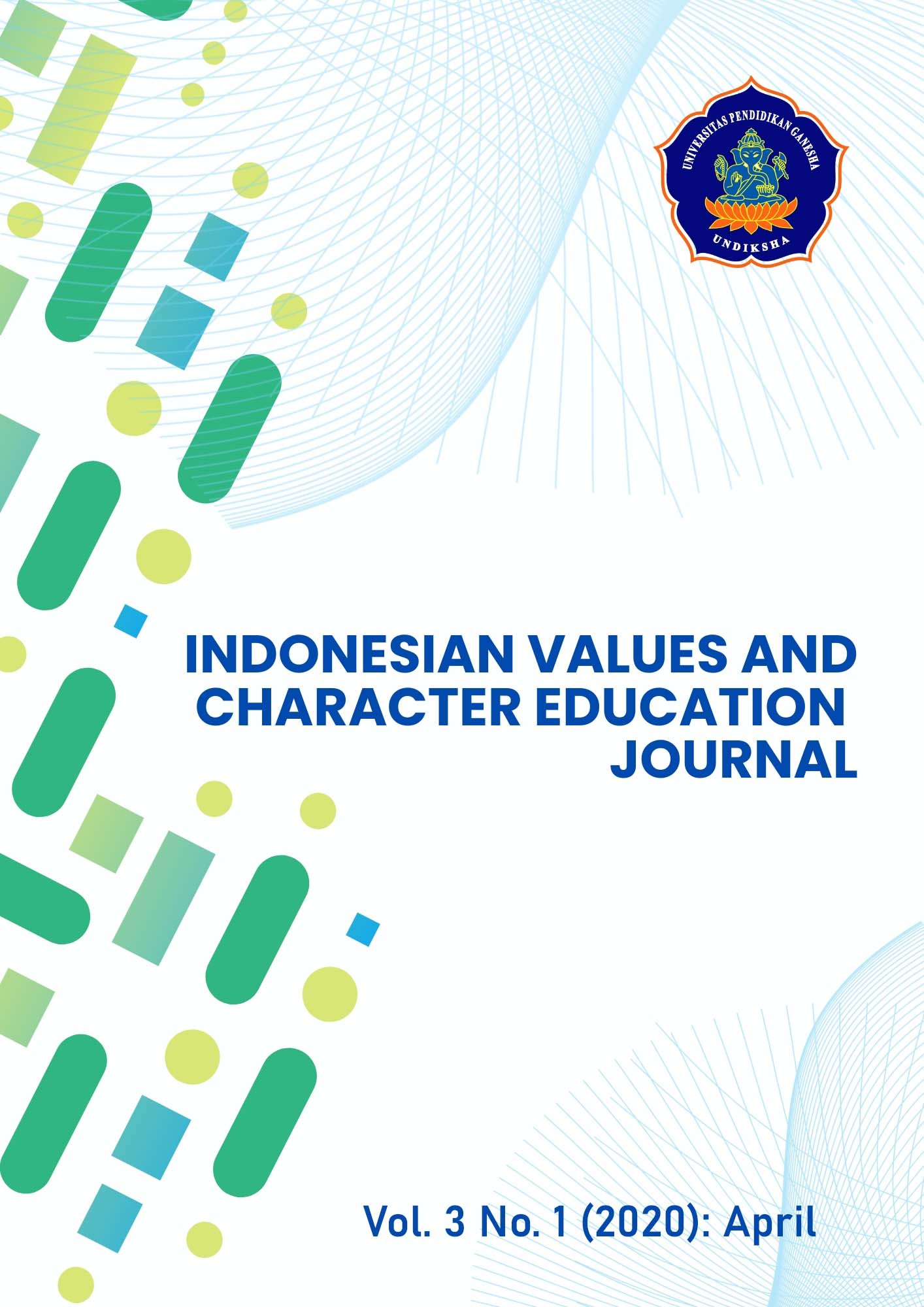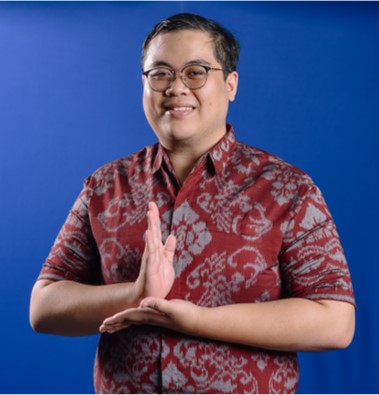The Discrepancy Between Teachers Perception and Implementation of Teaching Creativity
DOI:
https://doi.org/10.23887/ivcej.v3i1.26106Abstract
Latar belakang penelitian ini adalah adanya perbedaan antara persepsi guru dan fakta sebagaimana diamati dalam pengajaran kuragnya kesiapan kreativitas guru dalam mengajar Penelitian ini bertujuan untuk mengamati bagaimana guru mempersepsikan kreativitas mengajar mereka di kelas dan bagaimana mereka menerapkannya di dalam kelas. Fokus dari penelitian ini adalah untuk mengidentifikasi perbedaan antara persepsi guru dan fakta sebagaimana diamati dalam mengajar kreativitas di kelas. Metode campuran tertanam digunakan sebagai desain penelitian di mana satu data akan dominan daripada yang lain. Dalam penelitian ini, data kualitatif lebih dominan daripada data kuantitatif atau QUAL (quan). SMA Negeri 1 Tabanan dipilih sebagai tempat penelitian dan dua guru bahasa Inggris dipilih sebagai subjek penelitian. Dua kuesioner yaitu kuesioner yang dinilai sendiri dan lembar observasi kelas digunakan sebagai instrumen. Hasil dalam penelitian ini menunjukkan bahwa guru merasakan kreativitas mengajar mereka dalam kriteria kreatif. Selain itu hasil pengamatan menunjukkan bahwa kreativitas guru dikategorikan sedikit kreatif. Data-data tersebut menunjukkan bahwa ada perbedaan antara persepsi guru dan fakta sebagaimana diamati dalam pengajaran yang sebenarnya. Implikasi dari penelitian ini adalah bahwa penelitian ini akan digunakan oleh guru untuk mengetahui sejauh mana kreativitas yang dimiliki oleh guru dalam mengajar di kelas, para guru akan mengetahui apakah kegiatan yang mereka lakukan termasuk kreatif atau kurang kreatif.
References
Ajmain, M. T., Hehsan, A., & Mohamad, A. M. (2019). Learning and Facilitation (PdPc) Islamic Education in Industrial Revolution 4.0. Journal of Research in Psychology, 1(3), 13-17. https://doi.org/10.31580/jrp.v1i3.975 DOI: https://doi.org/10.31580/jrp.v1i3.975
Avsec, S., & Savec, V. F. (2019). Creativity and critical thinking in engineering design: the role of interdisciplinary augmentation. Global Journal of Engineering Education, 21(1), 30-36.https://doi.org/10.1080/10400419.2019.1641678 DOI: https://doi.org/10.1080/10400419.2019.1641678
Ayob, A., Hussain, A., & Majid, R. A. (2013). A review of research on creative teachers in higher education. International Education Studies, 6(6), 8–14. https://doi.org/10.5539/ies.v6n6p8 DOI: https://doi.org/10.5539/ies.v6n6p8
B Boholano, H. (2017). SMART SOCIAL NETWORKING: 21st CENTURY TEACHING AND LEARNING SKILLS. Research in Pedagogy, 7(1), 21–29. https://doi.org/10.17810/2015.45 DOI: https://doi.org/10.17810/2015.45
Boden, M. A. (1998). Creativity and artificial intelligence. Artificial Intelligence, 103(1–2), 347–356. https://doi.org/10.1093/acprof:oso/9780199836963.003.0012 DOI: https://doi.org/10.1016/S0004-3702(98)00055-1
Cayirdag, N. (2017). Creativity fostering teaching: Impact of creative self-efficacy and teacher efficacy. Kuram ve Uygulamada Egitim Bilimleri, 17(6), 1959–1975. https://doi.org/10.12738/estp.2017.6.0437 DOI: https://doi.org/10.12738/estp.2017.6.0437
Chen, C. W. J., & Lo, K. M. J. (2019). From Teacher-Designer to Student-Researcher: a Study of Attitude Change Regarding Creativity in STEAM Education by Using Makey Makey as a Platform for Human-Centred Design Instrument. Journal for STEM Education Research, 2(1), 75-91. DOI: https://doi.org/10.1007/s41979-018-0010-6
Chi, H., Yeh, H., & Wu, S. F. (2014). How Well-Being Mediates the Relationship between Social Support and Teaching Effectiveness. Journal of Education and Learning, 3(4), 117–130. https://doi.org/10.5539/jel.v3n4p117 DOI: https://doi.org/10.5539/jel.v3n4p117
Choo, S. S. (2020). Examining models of twenty-first century education through the lens of Confucian cosmopolitanism. Asia Pacific Journal of Education, 40(1), 20-34. https://doi.org/10.1080/02188791.2020.1725435 DOI: https://doi.org/10.1080/02188791.2020.1725435
Cooper, M. M., Stowe, R. L., Crandell, O. M., & Klymkowsky, M. W. (2019). Organic chemistry, life, the universe and everything (OCLUE): a transformed organic chemistry curriculum. Journal of Chemical Education, 96(9), 1858-1872. https://doi.org/10.1021/acs.jchemed.9b00401 DOI: https://doi.org/10.1021/acs.jchemed.9b00401
de Sousa, F. C. (2011). Creative Teaching and Efffective Teaching in Higher Education. International Journal of Organizational Innovation, 3(4), 5–44.
Fitriah. (2018). The role of technology in teachers’ creativity development in english teaching practices. Teflin Journal, 29(2), 177–193. https://doi.org/10.15639/teflinjournal.v29i2/177-193 DOI: https://doi.org/10.15639/teflinjournal.v29i2/177-193
Gumusluoglu, L., & Ilsev, A. (2009). Transformational leadership, creativity, and organizational innovation. Journal of Business Research, 62(4), 461–473. https://doi.org/10.1016/j.jbusres.2007.07.032 DOI: https://doi.org/10.1016/j.jbusres.2007.07.032
Horng, J. S., Hong, J. C., ChanLin, L. J., Chang, S. H., & Chu, H. C. (2005). Creative teachers and creative teaching strategies. International Journal of Consumer Studies, 29(4), 352–358. https://doi.org/10.1111/j.1470-6431.2005.00445.x DOI: https://doi.org/10.1111/j.1470-6431.2005.00445.x
Hysa, E. (2014). Defining a 21 st century education: Case study of development and growth course. Mediterranean Journal of Social Sciences, 5(2), 41–46. https://doi.org/10.5901/mjss.2014.v5n2p41 DOI: https://doi.org/10.5901/mjss.2014.v5n2p41
Khodabakhshzadeh, H., Hosseinnia, M., Moghadam, H. A., & Ahmadi, F. (2018). EFL teachers’ creativity and their teaching’s effectiveness: A structural equation modelling approach. International Journal of Instruction, 11(1), 227–238. https://doi.org/10.12973/iji.2018.11116a DOI: https://doi.org/10.12973/iji.2018.11116a
Kurilovas, E., & Kubilinskiene, S. (2020). Lithuanian case study on evaluating suitability, acceptance and use of IT tools by students–An example of applying Technology Enhanced Learning Research methods in Higher Education. Computers in Human Behavior, 107, 106274. https://doi.org/10.1016/j.chb.2020.106274 DOI: https://doi.org/10.1016/j.chb.2020.106274
Malebese, M. E. L., & Tlali, M. F. (2019). Teaching of English first additional language in rural learning environments: a case for problem-based learning. International Journal of Inclusive Education, 1-12. https://doi.org/10.1080/13603116.2018.1544300 DOI: https://doi.org/10.1080/13603116.2018.1544300
Menggo, S., Suastra, I., Budiarsa, M., & Padmadewi, N. N. (2019). Needs Analysis of Academic-English Speaking Material in Promoting 21st Century Skills. International Journal of Instruction, 12(2), 739-754. https://doi.org/10.1080/20004508.2019.1627844 DOI: https://doi.org/10.29333/iji.2019.12247a
Motallebzadeh, K., Ahmadi, F., & Hosseinnia, M. (2018). Relationship between 21st century skills, speaking and writing skills: A structural equation modelling approach. International Journal of Instruction, 11(3), 265–276. https://doi.org/10.12973/iji.2018.11319a DOI: https://doi.org/10.12973/iji.2018.11319a
Morris, T. H. (2020). Creativity through self-directed learning: three distinct dimensions of teacher support. International Journal of Lifelong Education, 1-11. https://doi.org/10.1080/02601370.2020.1727577 DOI: https://doi.org/10.1080/02601370.2020.1727577
Nee, K., & Yahaya, N. (2016). Connections Between Creative Teacher and Their Creativity in Teaching. Malaysian Journal of Higher Order Thinking Skills in Education, (November), 1–29.
Nouri, J., Zhang, L., Mannila, L., & Norén, E. (2020). Development of computational thinking, digital competence and 21st century skills when learning programming in K-9. Education Inquiry, 11(1), 1-17. https://doi.org/10.1016/j.cedpsych.2020.101862 DOI: https://doi.org/10.1080/20004508.2019.1627844
Pease, R., Vuke, M., June Maker, C., & Muammar, O. M. (2020). A practical guide for implementing the STEM assessment results in classrooms: Using strength-based reports and real engagement in active problem solving. Journal of Advanced Academics, 1932202X20911643. https://doi.org/10.1177/1932202X20911643 DOI: https://doi.org/10.1177/1932202X20911643
Pendidikan, P. R., Teknologi, D. A. N., Pgri, U., & Tuban, R. (2010). DI ERA PENGETAHUAN Dede Nuraida. Data Base, 1(2), 1–7.
Peranginangin, S. A., Saragih, S., & Siagian, P. (2019). Development of learning materials througPBL with Karo culture context to improve students’ problem solving ability and self-efficacy. International Electronic Journal of Mathematics Education, 14(2), 265-274. https://doi.org/10.29333/iejme/5713 DOI: https://doi.org/10.29333/iejme/5713
Pishghadam, R., & Shayesteh, S. (2012). Creativity and its Relationship with Teacher Success. Brazilian English Language Teaching Journal, 3(2). DOI: https://doi.org/10.4304/jltr.2.4.909-917
Putranta, H., & Supahar, S. (2019). Development of physics-tier tests (PysTT) to measure students' conceptual understanding and creative thinking skills: a qualitative synthesis. Journal for the Education of Gifted Young Scientists, 7(3), 747-775. https://doi.org/10.17478/jegys.587203 DOI: https://doi.org/10.17478/jegys.587203
Runco, M. A., & Jaeger, G. J. (2012). The Standard Definition of Creativity. Creativity Research Journal, 24(1), 92–96. https://doi.org/10.1080/10400419.2012.650092 DOI: https://doi.org/10.1080/10400419.2012.650092
Rustaman, N. Y., Tapilouw, F. S., & Hidayat, T. (2019). Students'Concept Mastery: Reasoning Ability and Concept Mastery of Evolution. Indonesian Journal of Social Research (IJSR), 1(1), 23-29. https://doi.org/10.30997/ijsr.v1i1.7 DOI: https://doi.org/10.30997/ijsr.v1i1.7
Setiono, P., & Rami, I. (2017). Kreativitas Guru Dalam Menggunakan Media Pembelajaran Di Kelas V Sekolah Dasar. Jurnal Gentala Pendidikan Dasar, 2(2), 219–236. https://doi.org/10.22437/gentala.v2i2.6808 DOI: https://doi.org/10.22437/gentala.v2i2.6808
Suifan, T. S., & Al-janini, M. (2017). The Relationship between Transformational Leadership and Employees’ Creativity in the Jordanian Banking Sector. International Review of Management and Marketing, 7(2), 284–292.
Supardi , S., & Hasanah, E., (2020) Junior High School Students' Experiences of High Technology Based Learning in Indonesia. International Journal of Learning, Teaching and Educational Research, 19(5), 153-166. https://doi.org/10.26803/ijlter.19.5.9 DOI: https://doi.org/10.26803/ijlter.19.5.9
Triyoko, H. (2012). Implementing a Student-Centered Pedagogy: Doing so in the Indonesian Teaching-Learning Context. Register Journal, 5(2), 1. https://doi.org/10.18326/rgt.v5i2.242 DOI: https://doi.org/10.18326/rgt.v5i2.242
Wahyudi, W., Verawati, N. N. S. P., Ayub, S., & Prayogi, S. (2019). The effect of scientific creativity in inquiry learning to promote critical thinking ability of prospective teachers. International Journal of Emerging Technologies in Learning (iJET), 14(14), 122-131. DOI: https://doi.org/10.3991/ijet.v14i14.9532








